Over the years we have had numerous instances where we advised customers to replace certain parts in pairs. More often than not we get asked why we need to replace something if only one side is worn or even broken. In this short article we will explain why it is so important to replace critical safety components in pairs. Not only will it safe you money on related repairs but it will also extend the lifespan of your vehicle.

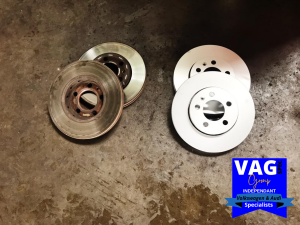
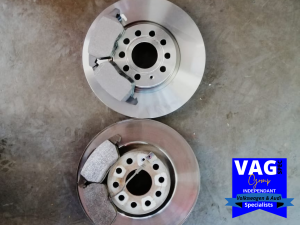
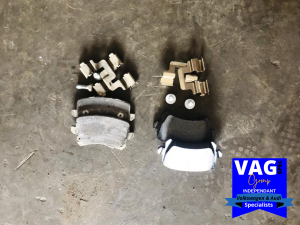
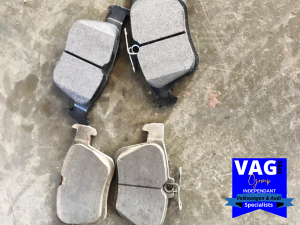
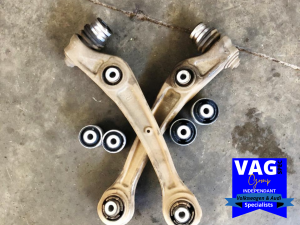
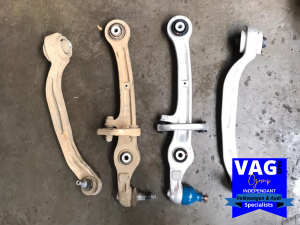
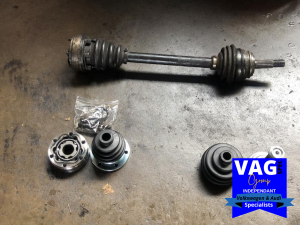
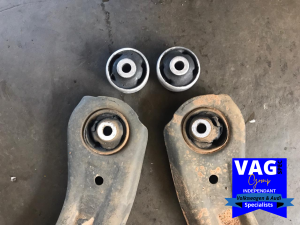
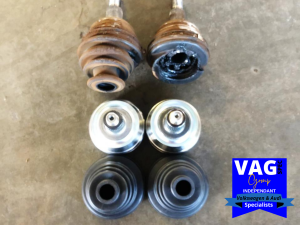
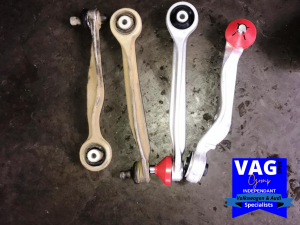
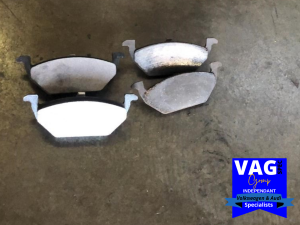
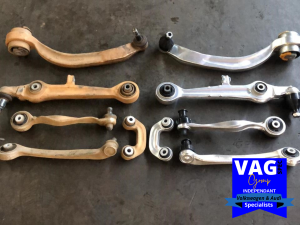
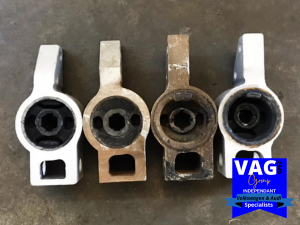
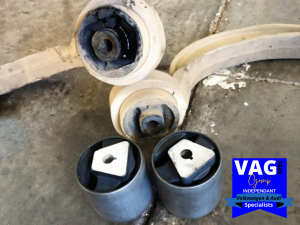
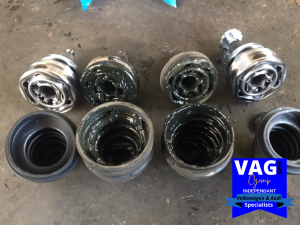
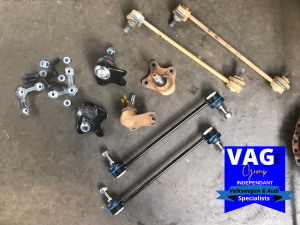
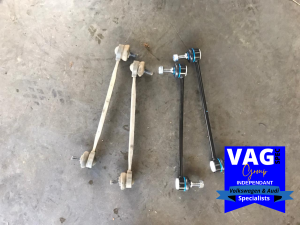
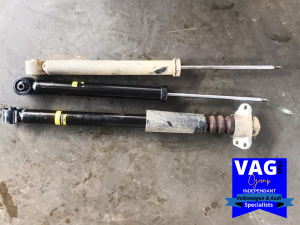
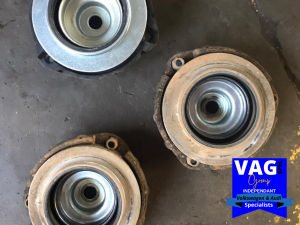
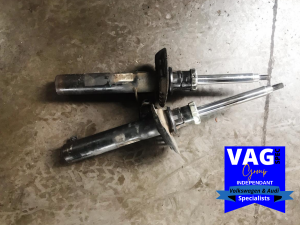
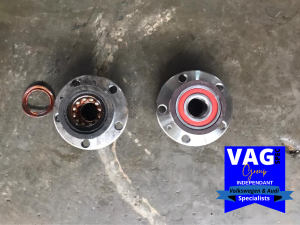
WHY REPLACE IN PAIRS?
There are lots of parts on a vehicle that should be replaced in pairs. Some of those would include brake parts or suspension parts. These parts are usually replaced in pairs because if one side is worn, the other side should be equally worn.
Here are some parts that are recommended to be replaced in pairs:
Brake pads & Brake discs
Shock absorbers & strut(shock top) mountings
Ball joints & steering rack ends
Upper & Lower control arms
Wheel bearings
Inner and Outer Cv joints
Brake Pads & Brake Disc
What are brake discs?
The brake discs are attached to each wheel of the vehicle. Brake pads clamp down onto the brake discs in order to stop the wheels from turning. Brake discs are type specific to the vehicle make and model.
Why should brake discs be replaced at the same time?
Brake discs will usually have the same amount of wear on both sides. It is recommended that both sides be replaced at the same time to maintain even braking as any difference in the disc thickness will cause the brakes to pull to one side.
How often should brake discs be replaced?
If maintained well, brake discs should be replaced between every 80 000 to 110 000 km, but there are a number of factors that can affect their lifespan.
Common symptoms of bad/worn brake discs
Vibration/Shaking/Shuddering:
When discs are very worn, the contact between the disc and the pads can be uneven. This lack of contact results in vibration and shaking. This can be felt through the brake pedal and steering wheel.
Unusual noises
Worn brake discs are noisy. Squealing and squeaking is a sure sign of the discs beginning to wear. Grinding and scraping noises indicate severely worn discs.
Visible damage
New brake discs are smooth – smooth surfaces ensure good contact with the brake pads. As they wear, the discs become scraped and grooved and causes impaired contact with the brake pads.
Delayed stopping distance
Worn/damaged brake discs will compromise the brake system’s ability to stop the car in an acceptable distance.
Consequences of not replacing worn/bad brake discs
If you don’t replace the brake discs when needed, you risk brake failure and possibly an accident. The discs absorb the heat when the brakes are applied. The thinner the disc, the more heat is absorbed. The excess heat damages the discs. Damaged discs are uneven, causing the brake pads to move around. Damaged discs increase the stopping distance, which could cause a serious accident.
What are brake pads?
Brake pads are parts that, when the brake pedal is pressed, clamp down on the brake discs to apply pressure and friction. The friction stops the wheels from turning, which stops the vehicle. Like brake discs, brake pads are type specific to the vehicle make and model.
Why should brake pads be replaced at the same time?
Both sides of the brake system are equal and work evenly to stop the vehicle. When the brakes are applied, the brake pads push against the brake discs. If the brake pads are worn unevenly it could stop one wheel faster than the other, causing the vehicle to swerve.
How often should brake pads be replaced?
Brake pads should be replaced between every 16 000 to 30 000 km to keep the wear to a minimum and depending on the drivers’ driving habits.
Common symptoms of bad/worn brake discs
Noises:
When the brakes are applied and there is a squealing sound, this could definitely mean the brake pads are worn. With age, brake pads build up dust that will make a squealing sound each time they are used. Not only that, but when the brake pads get to worn down the brake sensor will connect with the brake discs. This will cause a scraping noise when the brakes are applied.
Spongy brake pedal
If you step on the brake pedal and it feels hard/spongy, it may indicate worn brake pads. This will cause you to apply more pressure to the brake pedal than normal.
Slower brakes
When the brake pads are extremely worn out, they won’t be able to apply enough friction to the brake discs to quickly slow down the vehicle, causing the brake response to be very slow each time the brakes are applied.
Scratches on brake disc surfaces
Very worn-down brake pads will go into the surface of the brake disc and cause scratches and grooves in the brake disc surface.
Consequences of not replacing worn/bad brake pads
Worn down brake pads could cause the brake disc to get damaged and brake. The lack of brake pads means that the heat from the friction won’t disperse correctly and could cause the whole braking system to overheat and fail.
Shock Absorbers
Shock absorbers are hydraulic (oil) pump like parts that help to control the impact and rebound movement of the vehicles’ springs and suspension. Along with smoothing out bumps and vibrations, the key role of shock absorbers is to ensure that the vehicle’s tyres remain in contact with the road surface at all times, which ensures safe control and braking response form the vehicle.
Why should shock absorbers be replaced at the same time?
Anytime shock absorbers needs to be replaced, the other one across the same axle (front or rear) must also be replaced to ensure that both shocks are in equivalent working condition. New shocks have not experienced any wear, pairing it with an old shock will create uneven damping characteristics across the axle. This causes the new shock to overcompensate, putting it at higher risk of damage and premature wear.
How often should shock absorbers be replaced?
It’s recommended that shock absorbers be tested every 20 000 km. A good indication of the shocks conditions is to look for any dents, rust, leaks or any other damage. If you drive on uneven, bumpy gravel roads you will, most likely need to replace the shock absorbers more often than usual.
Common symptoms of bad/worn shock absorbers
Excessive bouncing, swerving and diving:
When you drive over a bump and the vehicle continue to bounce, the shock absorbers may be the cause. The bouncing may also cause the tyres to wear unevenly. Bad/worn shocks can also cause the front of the vehicle to dive forward when you brake. This can make the vehicle shift its weight in the opposite direction on a turn, causing it to swerve.
Uneven tyre wear:
Uneven tyre wear caused by the shocks may look different than normal tyre wear. This type of tyre wear is called “cupping” or “scalloping”. Cupping means that there are only certain spots of the tyre with excessive wear. A bad shock absorber will cause the tyre to bounce, hitting the road on different points. This bouncing motion may cause the uneven patches you see in cupping.
Longer stopping distances:
Shocks play an important role in weight distribution of the vehicle. Front shocks help hold the front of the vehicle up and distributes the weight further back on the vehicle. When the front shocks go bad more weight comes forward. When braking, the weight shifts forward, putting more strain on the brakes causing a slower braking response and longer stopping distance.
Steering wheel vibration:
When the steering wheel vibrates excessively when you drive over a bump or on even road, it indicates worn/bad shock absorbers.
Consequences of not replacing worn/bad shock absorbers
Driving with bad/worn shocks is a safety risk because it compromises the stability of your vehicle. You will experience poor handling, excessive body roll, a loose steering wheel, poor traction, uneven tyre wear, reduced braking efficiency and premature wear of other suspension part if the shocks are not replaced.
Shock Mountings
Shock mountings are a part of the vehicle’s suspension system that connects the shock to the body of the vehicle. The shock mounting keeps the shock in place when the vehicle is in motion. It also keeps out the tyre noise and vibrations from the vehicle.
Why should shock mountings be replaced at the same time?
Shock mountings usually go through the same distance and road conditions meaning if one side is worn, the other side will be to. Therefore, it’s advisable to replace both right and left at the same time. Doing this will ensure their performance is evenly matched across the axle for a balanced ride. An imbalance on either side could impact both body and wheel movement, compromising the vehicle’s handling
How often should shock mountings be replaced?
Shock mountings do not need replacement unless they are worn out or if there is another problem with them. Shock mountings should last up to 7-10 years, depending on where you live and your driving habits. If you live or travel to rural areas with bad roads or go off roads on mud, gravel, stone or sandy roads often, you’re shortening the life expectancy of the vehicle’s shock mount.
Common symptoms of bad/worn shock mountings.
Weird, knocking, squeaking noises:
Clunking or squeaking noises coming from the suspension system when driving could mean the shock mounts are worn out. The noise would come from two or more metal components hitting one another without the insulation of the mounting. Front strut mountings may also make a clunking noise when the steering wheel is turned.
Uneven tyre wear:
A damaged shock mounting can wobble and fail to keep the wheels aligned – leading to uneven tyre wear.
Excessive vibration:
Shock mounting provides insulation to the vehicle. If they are damaged, they won’t’ be able to absorb noised and vibrations. A worn strut mounting most likely won’t have any rubber left for insulation – leading to excessive vibrations while driving.
Difficulty steering:
In some vehicles, the bearings in the upper shock mounting also serves as a steering point. Meaning when it fails, the steering movement’s smoothness and response time may be affected – leading to steering difficulty/issues.
Worn rubber:
You need to replace the shock mounting if the rubber inside the mounting has cracked or disintegrated.
Excessive movement:
The shock mounting helps to absorb the impact of road bumps on the vehicle. If the mounting is worn it could loosen and fail to keep the shock in place. This could result in excessive bounce and movement while driving.
Worn shock absorbers:
A shock mounting in good condition should handle the vehicle weight and keep everything in place. A failed mounting cannot keep everything in place and could cause the shock to fall out – knocking against other vehicle components – leading to premature wear and costly repairs.
Consequences of not replacing worn/bad shock mountings
Driving with bad/worn shocks is a safety risk because it compromises the stability of your vehicle. You will experience poor handling, excessive body roll, a loose steering wheel, poor traction, uneven tyre wear, reduced braking efficiency and premature wear of other suspension part if the shocks are not replaced.
Ball Joints
Ball joint are a critical component of the front suspension, they connect various links and allow them to move. Ball joints consist of a ball and socket (similar to the hip joint of a human body).
They help form a connection between control arms and steering knuckles. This provides smooth movement within the suspension.
Ball joints allow the steering knuckles to move in different directions while ensuring they remain attached to the vehicle. This motion allows the wheels to move up and down and side to side as needed.
Why should ball joints be replaced at the same time?
It is recommended that all ball joint be replaced at the same time. If one ball joint has failed, chances are the other joint are nearing their lifespan as well. Replacing them all at once might be costly, but doing so restores the suspension to like-new condition and also eliminated the risk of other ball joint failing in the maybe near future. Ball joints on each side of the vehicle tend to have similar wear, making sense to replace them in pairs at the same time.
How often should ball joints be replaced?
Ball joint usually have a lifespan of 110 000 – 240 000 KM of driving. Their actual lifespan will depend on the drivers’ driving habits and road conditions.
Common symptoms of bad/worn ball joints.
Clucking noises from front suspension:
As ball joints start to wear out, they become loose and start to rattle and knock as the vehicle travels. Worn ball joints may knock/clunk when traveling on rough roads, speed bumps or when turning. If not replaced the noise will get louder as the ball joint wear out, or until they eventually completely fail and break.
Excessive vibration from the front of the vehicle:
Worn ball joint will be loose in their sockets and vibrate excessively as the vehicle is moving. The vibration will often stem from the affected ball joint from either side of the vehicle. In some cases, the vibration may be felt through the steering wheel as well.
Uneven wear on front tyres:
Either the inner or outer edges of the front tyres will wear down quicker than the rest of the tread, and is most likely caused by a worn ball joint. The wear must appear on either the inner or outer tread, and not on both, to indicate a worn-out ball joint.
Wandering steering wheel:
A wandering steering wheel is when the vehicle steering drifts from left to right on its own. Worn ball joint will cause the steering to wander which will require the driver to compensate for the issue.
Consequences of not replacing worn/bad ball joints
Ball joints will eventually wear from the amount of movement and friction they undergo and become loose. Loose ball joints will allow for more room to move which can affect wheel alignment, increase tyre wear and noises coming from the suspension. Ball joint’s lubrication can also dry out, this will allow water to get into the ball joint causing it to rust. Worn ball joints affects your ability to steer and control the vehicle. If a ball joint fails, the vehicles’ suspension could collapse or the wheel can fall off, causing the vehicle to lose control
Upper and Lower control arms
Control arms connects the steering knuckle to the frame and stabilizes the vehicle by allowing the chassis and the wheels to move in unison while the vehicle is in motion. Basically, the control arms help achieve coordination between the suspension and steering system, giving the driver the ability to steer the vehicle.
Control arms are one of the core components of the suspension system and serves as a direct connection point between the front wheel assemblies and the vehicles’ frame. Although control arms are simplistic in appearance, they have a vital role in the vehicle’s overall stability and drivability.
Why should control arms be replaced at the same time?
If one arm is worn out, the other arm most likely will be worn and need replacement as well. Both control arms undergo the same driving conditions that should cause them to have the same amount of wear. Replacing just one control arm will result in extra load on the old arm and will cause it to crack in no time.
How often should control arms be replaced?
Over time the control arm assembly (consisting of upper and lower control arms) can become worn or bent. They normally wear out between 145 000 – 160 000 km. Your driving conditions can have an effect on their lifespan.
Common symptoms of bad/worn control arms
Clunking noise:
The clunking noise will occur around the wheel with the bad control arm, and it will occur most frequently when driving over hills or uneven surfaces.
Vehicle pulling to the side:
If your vehicle pulls to either the right or left side while driving on a flat road, it could indicate that your control arms are going bad. If the bushing breaks down, the control arm will dangle in place. Not only does this cause a clunking noise, but it also causes the vehicle to pull to either the right or left side, depending on which control arm is bad.
Uneven tread wear:
Uneven tread wear is another sign that your vehicle’s control arms need replacing. The poor connection between the spring or strut and your vehicle’s chassis means that some tires will bear more weight than others. And the tires that bear more of your vehicle’s weight will naturally wear down more quickly than the rest.
Vibrations when driving:
Controls arms help reduce vibrations to create a smoother (and safer) driving experience. When they go bad, they won’t be able to reduce vibrations as effectively as they should. As a result, you may feel the bottom of your vehicle’s chassis shaking or your steering wheel vibrating while driving.
Consequences of not replacing worn/bad control arms
Having damaged control arms could cause other suspension parts to become misaligned. When this happens, you may experience issues with steering and handling. Steering would become unpredictable; the vehicle would pull to the side randomly even though you are keeping the steering wheel straight.
There are also the suspension parts that come in pairs but are not necessary to replace both sides at the same time. Even though you can do them one side at a time it is recommended that both sides be replaced at the same time. When one side is worn, the other side should be equally worn. Each side of the vehicle tend to have similar wear, which means it’s common to have them replaced in sets/matching pairs.
These parts include:
Stabilizer links
CV joints
Wheel bearings
Control arm bushes
The suspension is an integral part of the movement of your vehicle. In order to keep driving smoothly, these parts will need to be regularly maintained and also checked on a regular basis. All VAGSPEC CENTRE branches have qualified Vw or Audi technicians to give you the best advice on any maintenance or repairs needed. We have build a reputation as the go to VW/Audi specialist repair centre of choice in South Africa.
We have branches in:
Menlyn: VAG Spec Menlyn – Out of warranty Vw, Mercedes, Audi, BMW and SEAT specialists
Zeerust: VAG Spec Centre Zeerust – Out of warranty Vw, Audi and Seat auto service shop (vagspeczeerust.co.za)
Klerksdorp: Vagspec Klerksdorp – VW & Audi Specialists In Klerksdorp
Capetown: VAG Spec Centre Cape Town – Out of warranty Vw, Audi and Seat auto service shop (vagspecct.co.za)
George: (opening 1 September 2022) VAGspec Garden Route – Volkswagen, Audi, SEAT & Porche Specialist Repair Centre (vagspecgr.co.za)

